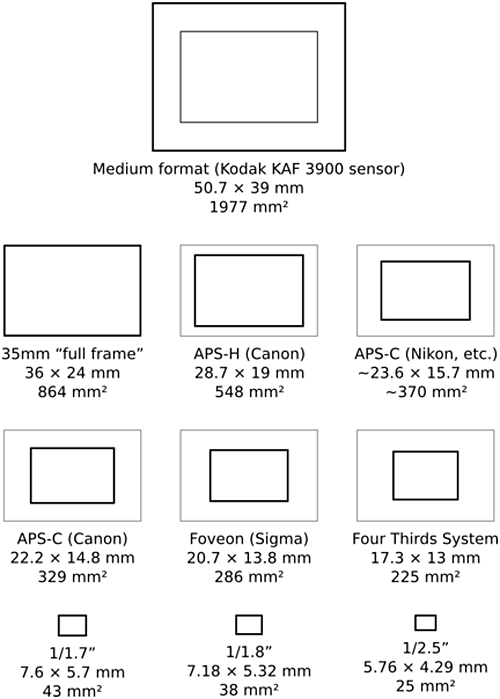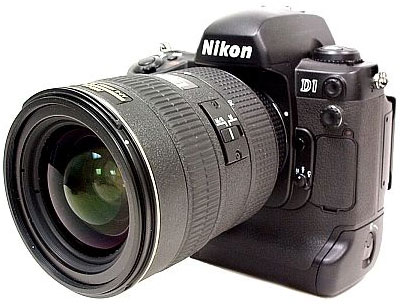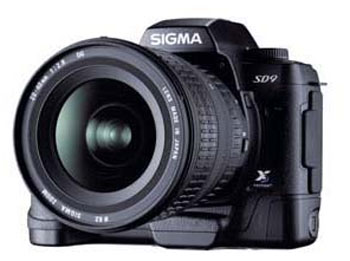The Digital Sensor: A Guide to Understanding Digital Cameras
by Wesley Fink on April 21, 2008 1:00 AM EST- Posted in
- Digital Camera
Sensor Size and Multipliers

Canon had become a dominant player in the SLR market after their successful launch of the EOS all-electronic mount for AF. Canon was also large enough with enough resources to develop and manufacture their own sensors. Canon launched a professional standard APS-H camera, with a 1.3X lens multiplier that used existing Canon 35mm lenses. Later, when Canon was ready to create a consumer digital SLR market they used a smaller 22.2x14.8mm sensor with an area of 328mm² and a lens multiplier of 1.6X. This is 38% the area of a full-frame sensor.
More recently, Canon has championed the full-frame sensor in their pro cameras and in their pro/amateur 5D model. Larger sensor manufacturing cost has dropped as digital sensors have evolved and it now appears likely the APS-H (1.3X lens multiplier) will eventually drop form the Canon line. Since no lenses depend on that image circle all current Canon full-frame lenses, such as those used with the APS-H cameras, will remain usable on the full-frame sensor pro models that will replace them.

Nikon, Pentax, and Minolta all had significant success in the 35mm film market, so all three had a vested interest in preserving their 35mm lens mount and keeping their current 35mm system users happy. However, none of these three had the resources to develop and manufacture their own sensors, so they partnered with sensor manufacturers to produce digital SLR cameras. In recent years that partner has been Sony, so all three manufacturers have basically adopted a larger 23.6x15.7mm sensor with a 1.5X lens multiplier.

Sony purchased the Photo Imaging division of Konica Minolta in 2006 and carried on the Minolta lens mount under the Sony brand. Today Sony both manufactures their own Sony brand cameras with Sony sensors and they continue to sell sensors to Nikon, Pentax, and Samsung.
Olympus was a huge player in the digital compact market as the market began its slow move to the digital SLR. While Olympus had been a very successful player in the film SLR market, they lost market in the SLR Auto-Focus wars kicked off by the success of the Minolta 7000. Olympus AF cameras remained a fringe product and Olympus eventually exited the market to concentrate on their compact digital offerings.

Olympus had a stake in the compact market remaining dominant and they had little legacy 35mm business to protect. Both developments made them late to the digital SLR market, but they made the best of it with a different approach than the other DSLR players. Olympus developed a new all-electronic DSLR lens mount and camera system based around a Kodak sensor with a 4:3 ratio instead of the 3:2 common in 35mm. With no legacy lenses to protect, the concept of lens multiplier is basically meaningless when talking about the Olympus DSLR system, but the diagonal is 1/2 the 35mm full-frame so lenses are equivalent to a 35mm lens at twice the focal length.
Olympus and its partners also made the 4/3 standard open - that is, it's available to any manufacturer. Currently Olympus, Panasonic, and Leica are producing 4/3 cameras and lenses but other manufacturers may join them in the future. Olympus is also now using sensors manufactured by Panasonic, a development partner, in their 4/3 cameras.

Sigma is best known as an independent lens manufacturer, but they have been producing SLR camera bodies for almost 30 years. Sigma introduced their first digital SLR with the SD9 in 2002. Sigma is the only DSLR manufacturer to use the unique Foveon sensor, which captures all three colors in a digital image in three layers - red, blue green - on a sensor. All other current digital sensors are based on Bayer sensors, which capture all three colors in mosaic patterns on a single sensor layer. Colors are then restored by an interpolation process called demosaicing, which theoretically converts the three color mosaics into smooth full-color images.
For this discussion, the current Sigma SD14 should be considered a niche DSLR player with very small market share. The Foveon sensor falls between 4/3 and the Canon 1.6 in size and has a 1.7X lens multiplier. Sigma is the only third party lens maker to produce lenses for all the camera systems discussed here. Some are full-frame designs with digital coatings to mount on full-frame or smaller digital sensor SLRs. Other designs are based on the largest 1.5X APS C image circle and are designed to work with smaller DSLR sensors ranging from 1.5X to 2X lens multiplier.










72 Comments
View All Comments
Midwayman - Friday, April 25, 2008 - link
I'm happy. I'll won't argue that it's not a variant, but its design is different enough to warrant a mention. Even for such an old sensor, it still produces a dynamic range that exceeds notables such as the 5d, etc. I know I love my Super CCD based f30.http://www.imaging-resource.com/PRODS/S3/S3PA6.HTM">http://www.imaging-resource.com/PRODS/S3/S3PA6.HTM
Has a reasonably good discussion on the super ccd for those interested.
haplo602 - Thursday, April 24, 2008 - link
http://www.fujifilm.com/products/digital_cameras/s...">http://www.fujifilm.com/products/digital_cameras/s...ElFenix - Wednesday, April 23, 2008 - link
http://gizmodo.com/383170/giz-explains-digital-cam...">http://gizmodo.com/383170/giz-explains-digital-cam...Ajax9000 - Monday, April 21, 2008 - link
Two criticisms of the article.1> The sensor size discussion was rather muddled, with half of the information on p.4 duplicating the info on p.2
2> Yes, full-frame is really nice to aspire to, but the problem of full-frame sensor cost was not mentioned. IC lithographic machines ("steppers") cannot image a FF sensor in a single pass, making the production time cost 2-3x greater than smaller sensors (APS-H is the biggest that can be done as single pass). Worse, the large size of the sensor compared to the wafer means that yields drop appreciably as the sensor size increases. All in all, FF sensors can be 10-20x more expensive than APS-C sensors, let alone 4/3, 1/1.8", etc.
See for example: p.68 in http://www.canon.com/technology/pdf/tech2008e.pdf">http://www.canon.com/technology/pdf/tech2008e.pdf and pp.11&12 in http://www.robgalbraith.com/public_files/Canon_Ful...">http://www.robgalbraith.com/public_files/Canon_Ful...
To quote Canon (2nd ref): "Regardless of future technological developments, cameras with full-frame sensors will always cost much more than cameras with smaller sensors."
ElFenix - Wednesday, April 23, 2008 - link
steppers used to not be able to make 35 mm sensors in one pass. as canon and nikon are two of the bigger stepper manufacturers, guess what has likely happened? and both of them are smart enough to not announce that they've made the larger stepper, so as to make more profit than the other.Wesley Fink - Tuesday, April 22, 2008 - link
Page 2 emphasized the huge size difference between compact point-and-shoot-sensors and DSLR sensors as classes of sensors. Page 3 then explored how all the DSLR sensor sizes evolved within that class, and page 4 detailed the current variations in sensor size within the DSLR class. I appreciate your comments, but can you provide some specifics on what needs to be changed?The full-frame sensor does indeed cost more, which was mentioned a number of times in the article. However, prices are still dropping for the full-frame sensor as evidenced by the fact that the street price of the Canon 5D is now around $2000.
Ajax9000 - Wednesday, April 23, 2008 - link
Some suggested edits:Page 1
[Delete http://images.anandtech.com/reviews/cameras/2008/s...">http://images.anandtech.com/reviews/cameras/2008/s... ]
Page 2
Sensors Today
Table: Sensor Comparison
Type Width (mm) Height (mm) Area (mm^2) Percent Full Frame Crop Factor (Lens Multiplier)
1/3.6" 4 3 12.00 1.39 8.49
1/3.2" 4.54 3.42 15.53 1.80 7.46
1/3" 4.8 3.6 17.28 2.00 7.07
1/2.7" 5.37 4.03 21.64 2.50 6.32
1/2.5" 5.76 4.29 24.71 2.86 5.91
1/2" 6.4 4.8 30.72 3.56 5.30
1/1.8" 7.18 5.32 38.20 4.42 4.76
1/1.7" 7.6 5.7 43.32 5.01 4.47
2/3" 8.8 6.6 58.08 6.72 3.86
1" 12.8 9.6 122.88 14.22 2.65
4/3" 18 13.5 243.00 28.13 1.89
"APS C" 23.7 15.7 372.09 43.07 1.52
APS C 25.1 16.7 419.17 48.52 1.44
APS H 30.2 16.7 504.34 58.37 1.31
35mm film 36 24 864 100 1.00
In the above Table we can see the range of sensor sizes now available. However, the majority of Compact or Point and Shoot cameras today still generally use a 1/2.3" to 1/2.5" sensor. A few top-of-the-line compact cameras, like the Canon G9, feature a 1/1.8" to 1/1.7" sensor; and the very best compact cameras have sensors around the 1/3" to 1/2" range. In contrast, the sensor sizes for today's DSLR cameras are in the range of 4/3" and APS C. A few top pro cameras now sport 35mm-size sensors and are referred to as full frame.
The APS C to 4/3 sensors of the bulk of today's digital SLR cameras are huge by comparison to those found in mainstream Compact or Point and Shoot cameras. To see the difference in the relative size of P&S sensors and DSLR sensors, look at the graphic below.
http://images.anandtech.com/reviews/cameras/2008/s...">http://images.anandtech.com/reviews/cameras/2008/s...
[Delete http://images.anandtech.com/reviews/cameras/2008/s...">http://images.anandtech.com/reviews/cameras/2008/s... ]
Why Does Sensor Size Matter?
...
Page 3
Why All these Different Sensor Sizes?
35mm first appeared on the scene in the 1930s, using an image frame of around 24x16mm. 35mm still film simply took 35mm motion picture film and spooled it into a light-tight canister, turned the spool direction by 90 degrees, and used double the frame size. (In fact, some early 35mm still cameras were referred to as "double-frame" cameras.) By the 1960s, with point-and-shoot and developments in SLR technology, 35mm had become king of the film formats. Even as film manufacturers tried to introduce other film formats, 35mm continued to grow and prosper.
...
... Actually, the image size that was always shot was the 30.2mm x 16.7mm, and the other sizes were just standard crops. The 24mm by 16mm APS C format is approximately the same size as the 1/2 frame 35mm championed by Olympus in the film era.
Page 4
Sensor Size and Multipliers
[Delete http://images.anandtech.com/reviews/cameras/2008/s...">http://images.anandtech.com/reviews/cameras/2008/s... ]
...
More recently, Canon has championed the full-frame sensor in their pro cameras and in their pro/amateur 5D model. Larger sensor manufacturing cost has dropped as digital sensors have evolved and it now appears likely the APS-H (1.3X lens multiplier) will eventually drop from the Canon line. Since no lenses depend on that image circle all current Canon full-frame lenses, such as those used with the APS-H cameras, will remain usable on the full-frame sensor pro models that will replace them.
The developing push for full-frame at the top of the current DSLR market is a move to a sensor that is a bit more than double the size of today's APS C sensors. And there is a significant problem with this -- the full-frame sensors are made using different process techniques to even APS H sized sensors, greatly increasing their relative costs. In short, the IC lithographic machines ("steppers") that make the sensors cannot image a full frame sensor in a single pass, making the production time cost 2-3x greater than smaller sensors (APS-H is the biggest that can be done as single pass). Worse, the large size of the sensor compared to the wafer means that yields drop appreciably as the sensor size increases. According to Canon USA, full frame sensors can be 10-20x more expensive than APS-C sensors.
(
As a comparison to computer components, most CPUs are less than 300mm^2. The very large and expensive G80 and R600 GPUs are about 480mm^2 and 420mm^2 respectively. Unlike CPUs and GPUs that can increase performance through a die-shrink, APS, 4/3, and full frame sensors have a fixed die size -- so Moores Law doesn't apply.
http://pc.watch.impress.co.jp/docs/2007/0423/kaiga...">http://pc.watch.impress.co.jp/docs/2007/0423/kaiga...
http://pc.watch.impress.co.jp/docs/2007/0705/kaiga...">http://pc.watch.impress.co.jp/docs/2007/0705/kaiga...
)
It is not surprising then that dSLRs mostly use APS C and 4/3 sensors.
Nikon, Pentax, and Minolta all had significant success in the 35mm film market, so all three had a vested interest in preserving their 35mm lens mount and keeping their current 35mm system users happy. However, none of these three had the resources to develop and manufacture their own sensors, so they partnered with sensor manufacturers to produce digital SLR cameras. Of course, these manufacturers were mostly making APS C, 4/3, and smaller sensors. In recent years that partner has been Sony, so all three manufacturers have basically adopted a 23.6x15.7mm sensor with a 1.5X lens multiplier.
...
CSMR - Monday, April 21, 2008 - link
I am not an expert but it seems to me the most important point has been missed in this article: depth of field. Larger sensors allow for greater depth of field with the same lens. There is a lot of discussion of "image quality" (resolution, shutter speed, sensitivity) but depth of field alters what the image is, which is more important.Wesley Fink - Monday, April 21, 2008 - link
In the interest of keeping the article somewhat basic and a digestible size we did not include a discussion of the depth of field variations with compact sensors compared to DSLR sensors.This IS an important concern for creative use of depth of field since the DOF is much greater with the smaller sensor than with the DSLR sensor. Not everyone would agree that a shallower depth of field on a DSLR is more desirable. It certainly might be in a portrait, but not in a sweeping landscape shot. The desired DOF depends on what you are shooting.
melgross - Tuesday, April 22, 2008 - link
This is a very complex subject for many people. It's not just the sensor size that determines depth of field.But, we also have perspective to worry about.